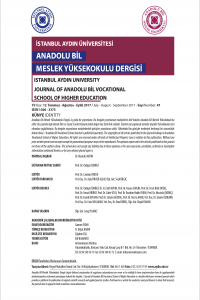Deniz yüzey sıcaklığının ARIMA yöntemiyle modellenmesi ve gelecek tahmini: Zonguldak ve Bartın uygulaması
Deniz Yüzey Sıcaklığı, İklim Değişikliği, Modelleme, ARIMA, Tahmin
Modeling of sea surface temperature with ARIMA method and future prediction in Zonguldak and Bartın
Sea Surface Temperature, Climate Change, Modeling, ARIMA, Future Prediction,
___
- Zhang, G. P. (2003). Time series forecasting using a hybrid ARIMA and neural network model. Neurocomputing, 159-175.
- Merchant, C. J. (2020). Adjusting for desert-dust-related biases in a climate data record of sea surface temperature. Remote Sensing, 2554.
- Merchant, C. E. (2019). Satellite-based time-series of sea-surface temperature since 1981 for climate applications. Scientific Data.
- Manabe, S. a. (1988). Two stable equilibria of a coupled oceanatmosphere model. Journal of Climate, 841-866.
- Mohamed, B. &. (2022). Sea Surface Temperature Variability and Marine Heatwaves in the Black Sea. Remote Sensing, 2383.
- Tokat, E. a. (2023). Climatology and Variability of Sea Surface Temperature in the Region of Turkish Straits System, 1982-2021. EGU General Assembly 2023, EGU23-15096.
- Cengiz, M. &. (2020). A solution of some commonly used optimization functions by a hybrid BFGS-PSO algorithm. ournal of the Faculty of Engineering and Architecture of Gazi University, 925-938.
- Gülhan Toğa, B. A. (2021). COVID-19 prevalence forecasting using Autoregressive Integrated Moving Average (ARIMA) and Artificial Neural Networks (ANN): Case of Turkey. ournal of Infection and Public Health, 811-816.
- Bollapragada, R. &.-J. (2018). A Progressive Batching L-BFGS Method for Machine Learning.
- K. Kalpakis, D. G. (2001). Distance measures for effective clustering of ARIMA time-series,” Proceedings 2001 IEEE International Conference on Data Mining. Proceedings 2001 IEEE International Conference on Data Mining, San Jose, (s. 273-280). San Jose, CA, USA.
- ISSN: 1306-3375
- Başlangıç: 2006
- Yayıncı: İstanbul Aydın Üniversitesi
Vanilya ve farklı alanlarda kullanımı
Ekin DİNÇEL KASAPOĞLU, Meryem BADAYMAN
Veri Madenciliği Analiz Yöntemleriyle İngilizce Hazırlık Sınıfı Başarı Analizi
Zeynep AYTOLU KÜLAHCİ, Zafer ASLAN
Fonksiyonel bir içecek şalgam suyunun üretimi ve muhafazası
Burç ERSOY, Nuray CAN, Aysun SAĞLAM
Fotovoltaik panel verimliliği ve maksimum güç noktası izleme
Kara Yüzey Sıcaklığının ARIMA Yöntemiyle Modellenmesi ve Gelecek Tahmini: Antalya Uygulaması
Türk Mutfağında Zeytin Ve Zeytinyağının Kullanımı Ve Sağlık Faydası
Kentsel ısı adası, sıcaklık dalgaları ve halk sağlığı ilişkisi
